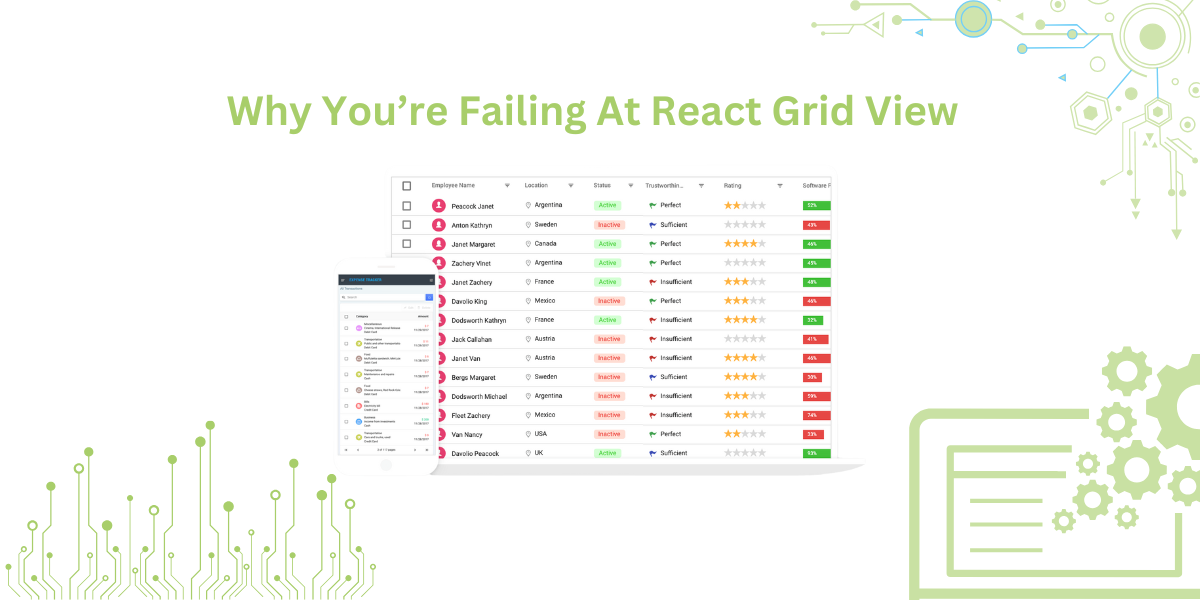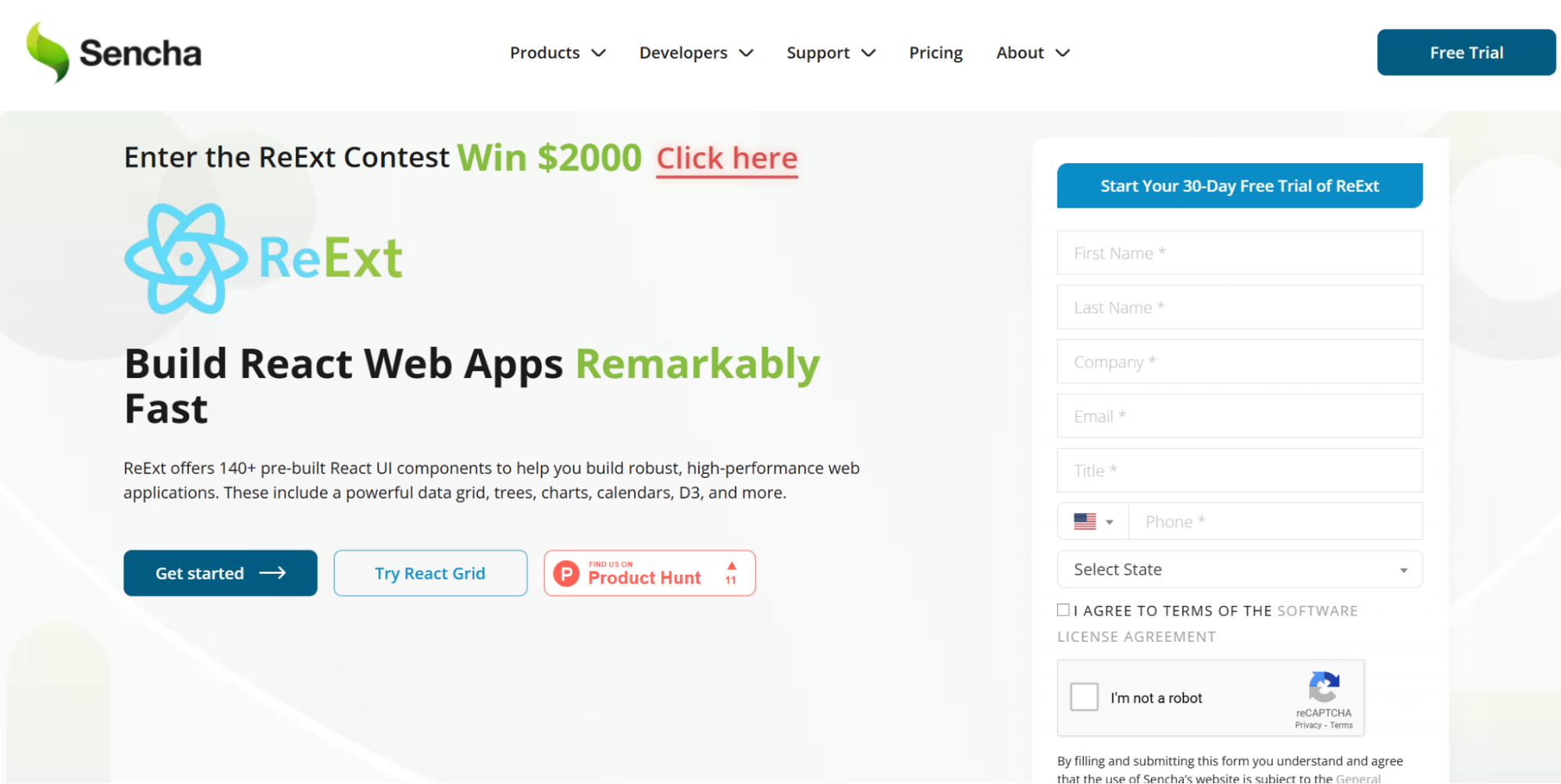Why You’re Failing At React Grid View
Grids are essential in web applications. They display, sort, and manage data effectively. However, a poorly implemented React grid view can harm your application. Slow performance and limited functionality frustrate users. Studies show that users abandon applications with poor experiences. This makes grid performance crucial.
In this blog, we explore common issues with React grid views. These include slow data loading and limited features. We also discuss challenges like scaling with growing datasets. Customization and adaptability are also key for long-term success. Sencha ReExt empowers developers to create high-performance React data grids and charts seamlessly, handling large datasets with built-in features like sorting, filtering, pagination, and interactive visualizations.
We will introduce Sencha ReExt as a solution. It helps developers build efficient, feature-rich grids. ReExt supports scalability and adapts to changing needs. Whether you’re managing tight deadlines or large datasets, this blog will guide you. Learn how to avoid common pitfalls and create better React grids.

Is Your React Grid View Failing To Load Data Efficiently?
Creating Grids is a fun Job. However, there are some secrets about JS grids that you might want to know.
Usually, we fill grids with a lot of data. Therefore, how efficiently the grid loads, the data is important when embedding a grid view to your websites.
Suppose the grid takes 2-3 minutes to load the complete data set. However, using React grid view, creating a grid with only a millisecond of load time from scratch can be tedious, especially if you are under a tight schedule.
So this can be something you could miss when building your grids with React grid view, which can lead to your project failure.
You need a better Grid view that handles efficient data loading on your behalf. Then you never need to worry about that.
Does Your React Grid View Fail To Provide All The Functionalities Your Customers Expect?
Not only the efficiency but also the functionalities offered by your data grid matters most for your project’s success.
Suppose your grid can only provide basic functionalities like sorting and searching but cannot provide more intuitive features like pagination and infinite scrolling.
In that case, there is a possibility that it cannot extend to provide more advanced features. With time, customer requirements can also be changed.
Therefore, your react grid view can fail with time if it is not easily adjustable and needs several plugins to provide additional functionalities. If you want to see examples of successful JS grids, this article might help you.

Can Your React Grid View Not Be Customized Easily?
Customizations are important when you work with any web component.
Suppose your React grid view needs to be used on another page with some customizations. Can you easily achieve it with minimal impact on your code?
If not, you will have to do additional work to support a customized grid whenever you want something different. Therefore, it is better to avoid such implementations at all costs and look for a better solution that enables you to do customizations without hassle.
This is where third-party Javascript frameworks like Sencha can help you.
Is Your React Grid View Failing To Handle Your Growing Data Set?
Data are bound to increase with time. If you have only thousands of data at your hand, you could have millions of data within the next couple of months or years.
Therefore, your React good must also accommodate this growing data without affecting the loading speed.
Your React grid can fail if you cannot easily improve the functionalities with growing data or increased data load speed. Therefore, it is better to go for an option that can handle these data changes without your need to worry about it.
What Is ReExt?
ReExt is a tool for integrating Ext JS components into React applications. It combines React’s flexibility with Ext JS’s robust UI components. It includes over 140 pre-built components like grids, charts, and forms. These components simplify the creation of complex, data-driven user interfaces. Developers can build feature-rich applications without starting from scratch. This saves time and ensures consistency in projects.
ReExt works with React and Ext JS versions 7.x and above. It integrates seamlessly into various development environments. It also supports cross-platform functionality. This ensures consistent performance across devices and browsers. ReExt is optimized for performance. It efficiently handles large datasets and complex interfaces. Applications remain responsive, even under heavy data loads.
Customization is another strength of ReExt. Developers can tailor components to specific project needs. This allows for unique user experiences while using pre-built tools. ReExt is easy to start with. It offers a 30-day free trial and can be installed via npm. Detailed documentation and support are available to assist developers.

How To Build A React Grid Using Sencha ReExt?
To build a React grid using Sencha’s ReExt, follow these steps:
Set Up Your React Project:
Ensure Node.js and npm are installed.
Initialize a new React application:
npx create-react-app reext-grid-app
cd reext-grid-appInstall ReExt:
Install ReExt via npm:
npm install @sencha/reextConfigure ReExt:
Copy the necessary configuration files from the ReExt package to your project.
Ensure your project’s build setup is compatible with ReExt’s requirements.
Import and Use the Grid Component:
In your React component file (e.g., App.js), import the ReExt Grid component:
import { Grid } from '@sencha/reext';Define the data and columns for the grid:
const data = [
{ id: 1, name: 'John Doe', age: 28 },
{ id: 2, name: 'Jane Smith', age: 34 },
// Add more data as needed
];
const columns = [
{ header: 'ID', dataIndex: 'id', width: 50 },
{ header: 'Name', dataIndex: 'name', flex: 1 },
{ header: 'Age', dataIndex: 'age', width: 100 },
];Render the Grid component within your React component:
function App() {
return (
<div className="App">
<Grid data={data} columns={columns} height={400} width={600} title="User Data" />
</div>
);
}
export default App;Run Your Application:
Start your development server:
npm startNavigate to http://localhost:3000 to see your React application displaying the ReExt grid with the specified data.
By following these steps, you can integrate a robust, feature-rich grid into your React application using Sencha’s ReExt, leveraging Ext JS components for enhanced functionality.
For a visual demonstration, you might find the following video helpful:
https://www.youtube.com/watch?v=ZnVgOP3GDZQ
Why Should You Use Sencha ReExt?
Sencha ReExt is a powerful tool for React developers. It integrates Ext JS components into React applications. It offers many advantages for building modern web applications.
Seamless Integration:
ReExt provides over 140 pre-built Ext JS components. These include grids, charts, and forms. Developers can easily use them in their React projects. This makes it easier to create complex user interfaces.
Enterprise-Grade Features:
ReExt is designed for large-scale applications. It handles extensive datasets efficiently. This makes it ideal for enterprise-level solutions.
Accelerated Development:
ReExt reduces the need for creating UI elements from scratch. This saves time and speeds up development. Developers can focus on building core functionalities instead.
Cross-Platform Consistency:
Applications built with ReExt work seamlessly across devices and browsers. This ensures a consistent user experience on all platforms.
Enhanced Productivity:
ReExt combines React’s flexibility with Ext JS’s components. This makes workflows smoother and more efficient. It helps developers create high-quality applications quickly.
Conclusion
If your React grid view is failing, reconsider your approach. Common problems include slow data loading and limited functionality. Lack of customization and poor scalability also cause issues. Grids that are not efficient struggle as your application grows. They may fail to handle larger datasets effectively.
A grid lacking advanced features can disappoint users. Adding plugins for basic functionality is time-consuming. This can impact project timelines and user satisfaction. A grid that doesn’t adapt to changing needs can lead to failure.
Sencha ReExt provides a better solution. It integrates Ext JS components into React seamlessly. Pre-built grids are customizable and load data quickly. Features like pagination and infinite scrolling enhance functionality. ReExt adapts easily to evolving requirements. It handles large datasets without compromising performance. Customizations are simple and efficient.
Using ReExt helps you avoid common grid issues. It allows you to build robust, scalable grids quickly. This ensures your project’s success and satisfies user expectations.
FAQs
1. How can I identify if my React grid view is inefficient?
Look for slow loading times or laggy performance. Check if the grid struggles to handle larger datasets. If users face delays, your grid might be inefficient. Consider better solutions like ReExt.
2. What are the benefits of using pre-built grid components instead of creating custom grids?
Pre-built components save time and effort. They are optimized for performance. Features like pagination and sorting are built-in. Tools like ReExt ensure reliability and scalability. You don’t need extensive coding.
3. Can I customize the grid styles and layout with ReExt?
Yes, ReExt allows easy customization. You can adjust layouts and styles as needed. It supports specific project requirements. Customization ensures a seamless user experience.
4. How does ReExt ensure compatibility with future project needs?
ReExt scales with your application. It handles large datasets efficiently. It adapts to changing project requirements. It supports modern React and Ext JS versions. This ensures long-term compatibility.
5. Is it difficult to integrate ReExt into an existing React project?
No, integration is simple. ReExt can be installed via npm. Clear documentation guides the process. It works seamlessly with React environments. Setup requires minimal effort.
Sign Up for free at ReExt to create scalable React grid solutions for your enterprise applications.

The Ext JS Data Grid is widely regarded as one of the most feature‑rich and…

The integration of LLMs into Web application development has moved well beyond simple content generation…

ReExt is a React library developed by Sencha that allows you to use Ext JS…










